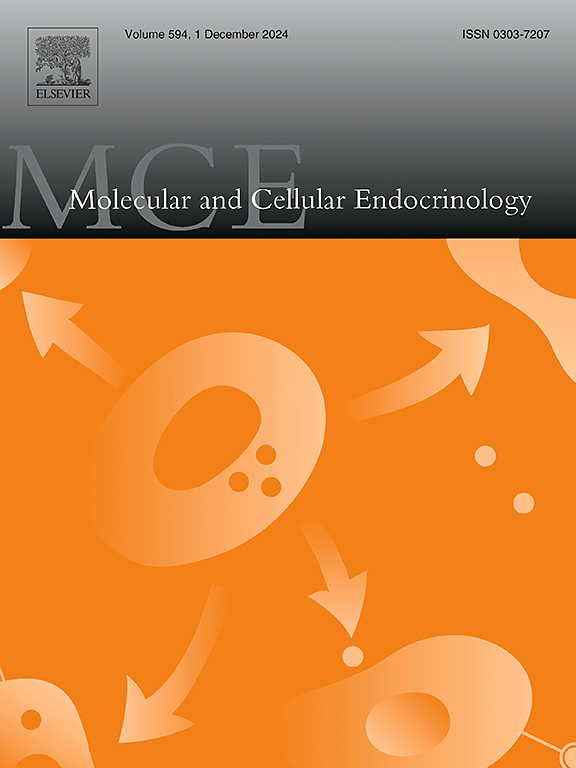Notch信号通过与成骨细胞缺氧和PTH通路的串扰调节Fgf23的表达。
IF 3.6
3区 医学
Q2 CELL BIOLOGY
引用次数: 0
摘要
成纤维细胞生长因子23 (Fgf23)是由骨骼产生的,主要功能是一种磷酸尿激素。我们之前报道过,成骨细胞中Notch细胞内结构域(NICD)的过表达会增强Fgf23在体内与骨软化症相关的表达。在这里,我们使用成骨细胞系UMR-106和IDG-SW3细胞研究了潜在的机制。NICD过表达增加了两种细胞类型的Fgf23水平。操纵RBPJ-κ活性,无论是显性负活性还是组成活性形式,表明notch介导的Fgf23表达依赖于RBPJ-κ。铁螯合剂去铁胺(DFO)可上调Fgf23的表达,而RBPJ-κ过表达则可抑制Fgf23的表达。短发夹RNA (shRNA)靶向缺氧诱导因子(HIF)-2α可部分减弱这种效应,但HIF-1α不能。DFO处理也增加了Notch1蛋白的表达,但没有增加Notch2和notth3的表达,与Notch靶mrna Hes1和Hey1的上调平行。此外,DFO提高了γ-分泌酶亚基的表达,而γ-分泌酶抑制剂抑制了DFO诱导的Notch1和Fgf23水平的升高,表明γ-分泌酶表达的增加促进了Notch加工。此外,Notch信号对甲状旁腺激素(PTH)诱导的Fgf23表达发挥了附加刺激作用,至少部分是通过与蛋白激酶A (PKA)途径的相互作用。总的来说,这些发现表明Notch信号通过与缺氧和PTH通路的串串调节Fgf23的表达,为Fgf23的调控提供了新的见解,并确定了Fgf23相关疾病的潜在治疗靶点。本文章由计算机程序翻译,如有差异,请以英文原文为准。
Notch signaling modulates Fgf23 expression through crosstalk with hypoxia and PTH pathways in osteogenic cells
Fibroblast growth factor 23 (Fgf23) is produced by bone and functions primarily as a phosphaturia hormone. We previously reported that overexpression of the Notch intracellular domain (NICD) in osteogenic cells enhances Fgf23 expression in association with osteomalacia in vivo. Here, we investigated the underlying mechanisms using osteogenic cell lines UMR-106 and IDG-SW3 cells. NICD overexpression increased Fgf23 levels in both cell types. Manipulating RBPJ-κ activity, either a dominant-negative or constitutively active form, revealed that Notch-mediated Fgf23 expression is dependent on RBPJ-κ. Treatment with iron chelator Desferrioxamine (DFO) upregulated Fgf23 expression, which was abolished by dominant-negative RBPJ-κ overexpression. This effect was partially attenuated by short hairpin RNA (shRNA) targeting hypoxia-inducible factor (HIF)-2α, but not HIF-1α. DFO treatment also increased expression of Notch1 protein, but not Notch2 and Nocth3, in parallel with upregulation of the Notch target mRNAs, Hes1 and Hey1. In addition, DFO elevated the expression of γ-secretase subunits, whereas a γ-secretase inhibitor suppressed DFO-induced increases in Notch1 and Fgf23 levels, suggesting that increased γ-secretase expression promotes Notch processing. Moreover, Notch signaling exerted an additive stimulatory effect on parathyroid hormone (PTH)-induced Fgf23 expression, at least in part through interaction with the protein kinase A (PKA) pathway. Co-immunoprecipitation assays revealed a physical interaction between NICD and CREB period Collectively, these findings demonstrate that Notch signaling regulates Fgf23 expression through crosstalk with hypoxic and PTH pathways, providing novel insights into Fgf23 regulation and identifying potential therapeutic targets for Fgf23-related disorders.
求助全文
通过发布文献求助,成功后即可免费获取论文全文。
去求助
来源期刊

Molecular and Cellular Endocrinology
医学-内分泌学与代谢
CiteScore
9.00
自引率
2.40%
发文量
174
审稿时长
42 days
期刊介绍:
Molecular and Cellular Endocrinology was established in 1974 to meet the demand for integrated publication on all aspects related to the genetic and biochemical effects, synthesis and secretions of extracellular signals (hormones, neurotransmitters, etc.) and to the understanding of cellular regulatory mechanisms involved in hormonal control.
 求助内容:
求助内容: 应助结果提醒方式:
应助结果提醒方式:


